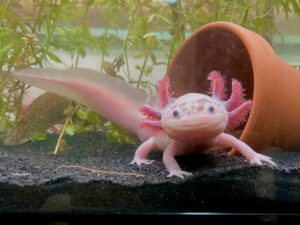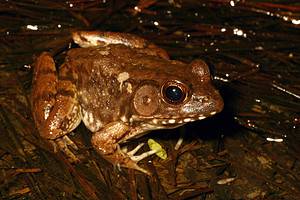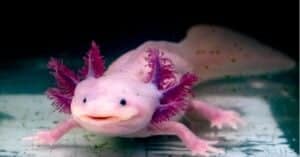Axolotls are salamanders that spend their whole lives underwater. These beautiful creatures start their lives as eggs and reach maturity at around one year of age. They are nearly extinct in their native habitat near Mexico City, with numbers still dwindling. However, they are more popular than ever as exotic pets and many more exist in captivity than in the wild. In this article, we’ll discuss the axolotl lifespan, stages, and how they compare to other salamanders!
How Long do Axolotls Live?
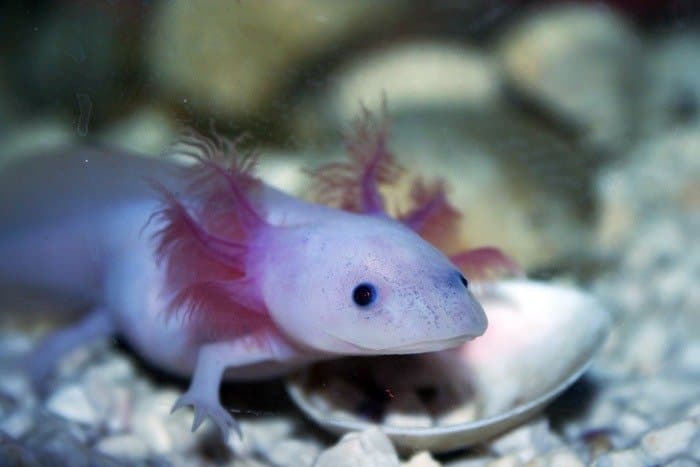
A half year old albino axolotl
©Orizatriz, CC BY-SA 3.0, via Wikimedia Commons – License
Axolotls typically live 10-15 years in captivity, but they can live for over 20 years when they’re well-cared for. The oldest axolotl is unknown but their age could surprise as they become more common pets as some salamander species have incredibly long lifespans (more on that below!)
Though the axolotl is a relatively short-lived salamander due to its small size, they do live longer than many people realize when adopting them as pets! Part of their resilience comes from their ability to regrow body parts such as limbs and even organs!
Axolotl Lifespan: Captivity vs. In the Wild
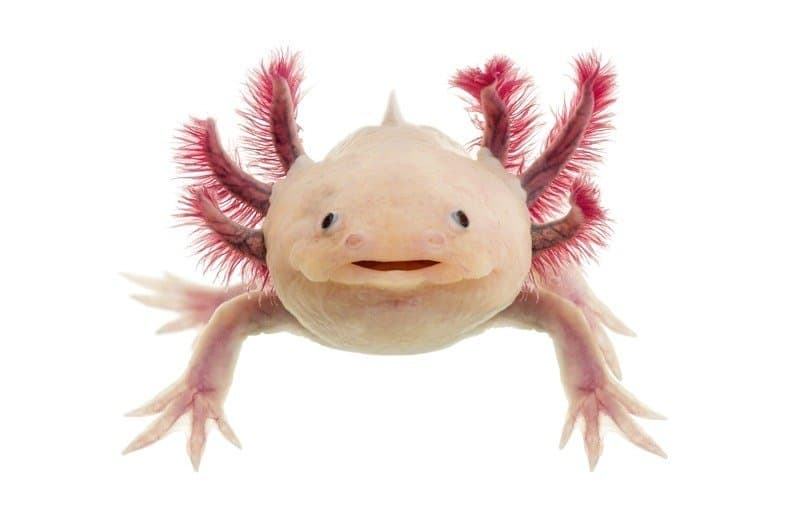
An axolotl saying hello!
©Eric Isselee/Shutterstock.com
Axolotls typically live 10-15 years in captivity and 5-10 years in the wild. What contributes to this massive difference in lifespan?
These salamanders face many threats in their native habitat, including predators, illness, and habitat loss.
However, captive life isn’t always a breeze either. As with many exotic pets, axolotls frequently receive substandard care.
Parents may buy one for their child, thinking that aquatic animals make easy pets to care for. They can also be impulse purchases, as many people do with small animals.
A well-cared-for axolotl can live up to 20 years, so adopting one is a huge commitment that shouldn’t be taken lightly!
Axolotl Development and Lifecycle
Axolotls live in water all of their lives, even breeding underwater. Their breeding season is from December to June, and females may lay up to 1000 eggs in a single season!
Once hatched, axolotls remain in a jelly-like substance. They will grow their head and body before entering their larva stage.
Baby axolotls are see-through and don’t have legs until two weeks into their larva stage. They remain in this stage until six months of age when they reach sexual maturity and are able to breed.
Axolotls are considered fully grown at one year old.
What are the Most Common Causes of Axolotl Death?
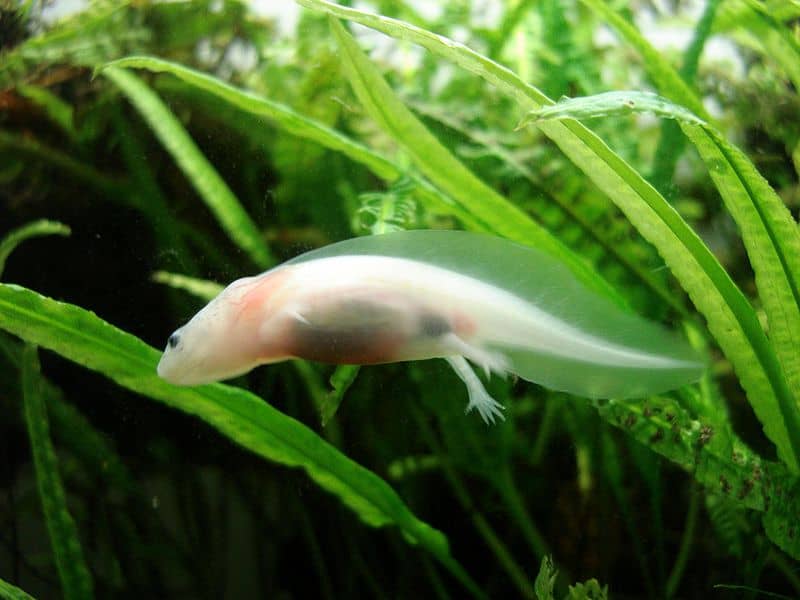
A white axolotl swimming among grassy reeds underwater
©I, Pouzin Olivier, CC BY-SA 3.0, via Wikimedia Commons – License
Predators
Axolotls don’t have much in the way of self-defense. They are slow-moving, with no teeth or claws. This makes them easy prey for predators in the wild.
Invasive species introduced to their native area have also preyed on axolotls.
Pollution
Their small native habitat in the lakes near Mexico City has been a downfall for the axolotl population. The species almost went extinct in 2010 due to water pollution and is still endangered in the wild today.
Health Problems
Axolotls are susceptible to health problems such as fluid build-up, tumors, bacteria, fungi, and parasites.
Some of the axolotl’s health problems stem from inbreeding. Unfortunately, their gene pool is only becoming smaller as they near extinction in the wild.
Many conditions also stem from poor care, such as lack of filtration in the tank, dirty water, or injuries due to poor tank set-up or handling.
Poor Care
In captivity, poor care can kill a fragile axolotl. Though they are relatively adaptive compared to most fish, they still have specific requirements that must be met—such as cool waters, a large tank, and the right substrate at the bottom of the tank.
Always do your research before adopting a pet, and don’t trust pet stores to tell you what’s best. They often only care about selling the animal, not what happens after adoption.
Due to their fragile bodies and limbs, as well as their slime coat, axolotls shouldn’t be handled or removed from the water.
The slime coat is a protective layer that prevents bacteria and parasites. It can be rubbed off by your hands or dried out if the axolotl is taken out of the water—so they’re a look, don’t touch kind of a pet!
Lastly, axolotls are known to jump out of their tanks. A lid is a must to keep them alive and in the water where they belong.
How does the Axolotl Lifespan Compare to Other Salamanders?
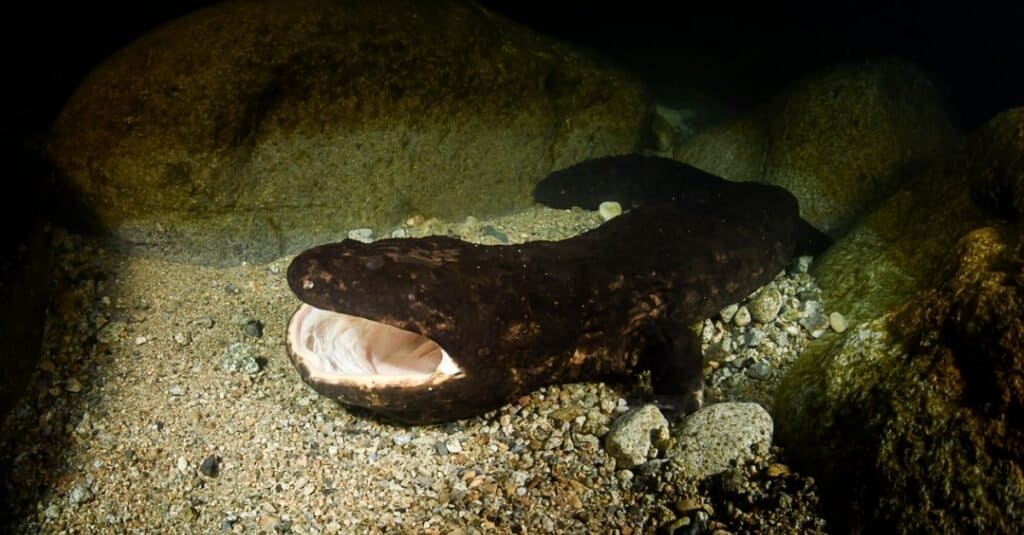
A Japanese
giant salamander
– as you can see they’re much larger than axolotls
©iStock.com/Martin Voeller
The longest-living documented salamanders have lived to be around 52 years old. They were Japanese giant salamanders in the Amsterdam Zoo. There have been reports of Chinese giant salamanders that could have reached ages much longer — media reports have claimed 200 years — but without more information the lifespan of giant salamanders remains unknown. However, these giant salamanders are the largest salamanders in the world and are not very closely related to the axolotl.
More comparable are the tiger salamander, which typically lives 10-16 years, and the spotted salamander, which lives about 20 years.
NEXT UP…
- Axolotl Colors: The 10 Types of Axolotl Morphs Did you know there are many kinds of axolotl?
- Pet Fish Guide: What You Need To Know Here is a great guide to help you get ready to bring home your new pet fish.
- Types of Pet Fish that Live Long There are many other types of aquarium companions that have very long lifespans.
The photo featured at the top of this post is © Eric Isselee/Shutterstock.com
Thank you for reading! Have some feedback for us? Contact the AZ Animals editorial team.



